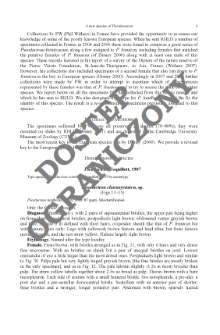
Obiekt
Tytuł: Classification, natural history, and evolution of Epiphloeinae (Coleoptera: Cleridae). Pt. 6, The genera Epiphlaeus Spinola and Opitzius Barr
Inny tytuł:
Annales Zoologici, vol. 58, no 1 ; Epiphloeinae ; The genera Epiphlaeus Spinola and Opitzius Barr
Współtwórca:
Muzeum i Instytut Zoologii Polskiej Akademii Nauk
Wydawca:
Miejsce wydania:
Opis:
Bibliogr. p. 33-34 ; P. 1-34 : ill. ; 27 cm ; Abstract in Spanish. Taxa in Latin
Typ obiektu:
Abstrakt:
New World genus Epiphlaeus is redefined and evolutionarily linked to its sister genus Opitzius Barr. Epiphlaeus includes six species as follows: E. adonis sp. nov., E. duodecimmaculatus (Klug), E. fundurufus sp. nov., E. princeps (Gorham), E. pulcherrimus (Gorham), E. quattuordecimmaculatus Chevrolat, and E. tigrinus sp. nov. The monotypic Opitzius is based on O. thoracicus Barr. Specimens of these two genera are variously deposited in 37 institutional and private collections. These checkered beetles frequent the surface of felled tree boles to forage on adults and immatures of lignicolous insects. Their large size and mobility make them very noticeable on the bark of fallen trees. It is postulated that they are participants in a mimetic ring with log-inhabiting mutillids and flies part of the mimetic mix. Hennigian principles were applied to 22 adult morphological characters, which yielded a nearly totally resolved phylogenetic hypothesis between Epiphlaeus and Opitzius, and among Epiphlaeus species groups. The combined geographical range of the inclusive species extends from northwestern Nicaragua to southeastern Brazil. It is hypothesized that ancestral Epiphlaeus – Opitzius evolved in South America with some descendants entering Insular Central America after closure of the Panamanian portals during the Miocene. Pleistocene climatic factors are thought to have influenced species diversity, and perhaps speciation events in conjunction with aspects of dispersal, vicariance, and taxon pulse dynamics.
Czasopismo/Seria/cykl:
Tom:
Zeszyt:
Strona pocz.:
Strona końc.:
Szczegółowy typ zasobu:
Format:
Identyfikator zasobu:
Źródło:
MiIZ PAN, call no. P.255, vol 58, no 1 ; MiIZ PAN, call no. P.4314, vol 58, no 1 ; kliknij tutaj, żeby przejść
Język:
Prawa:
Rights Reserved - Restricted Access
Zasady wykorzystania:
Digitalizacja:
Museum and Institute of Zoology of the Polish Academy of Sciences
Lokalizacja oryginału:
Library of the Museum and Institute of Zoology of the Polish Academy of Sciences
Dofinansowane ze środków:
Programme Innovative Economy, 2010-2014, Priority Axis 2. R&D infrastructure ; European Union. European Regional Development Fund
Dostęp:
Kolekcje, do których przypisany jest obiekt:
- Repozytorium Cyfrowe Instytutów Naukowych > Kolekcje Partnerów > Muzeum i Instytut Zoologii PAN > Czasopisma
- Repozytorium Cyfrowe Instytutów Naukowych > Kolekcje Partnerów > Muzeum i Instytut Zoologii PAN > Wydawnictwa MiIZ PAN > Annales Zoologici
- Repozytorium Cyfrowe Instytutów Naukowych > Piśmiennictwo > Czasopisma/Artykuły
Data ostatniej modyfikacji:
30 mar 2022
Data dodania obiektu:
26 kwi 2016
Liczba pobrań / odtworzeń:
34
Wszystkie dostępne wersje tego obiektu:
https://www.rcin.org.pl/publication/55558
Wyświetl opis w formacie RDF:
Wyświetl opis w formacie RDFa:
Wyświetl opis w formacie OAI-PMH:
Obiekty Podobne
Soldati, Fabien
Świętojańska, Jolanta
Kirejtshuk, Alexander Georgievich Leschen, Richard A. B.
Świętojańska, Jolanta Windsor, Donald M.
Węgrzynowicz, Piotr
Ślipiński, Stanisław Adam Burakowski, Bolesław
Ślipiński, Stanisław Adam
Nunberg, Marian (1896–1986)

 INSTYTUT ARCHEOLOGII I ETNOLOGII POLSKIEJ AKADEMII NAUK
INSTYTUT ARCHEOLOGII I ETNOLOGII POLSKIEJ AKADEMII NAUK
 INSTYTUT BADAŃ LITERACKICH POLSKIEJ AKADEMII NAUK
INSTYTUT BADAŃ LITERACKICH POLSKIEJ AKADEMII NAUK
 INSTYTUT BADAWCZY LEŚNICTWA
INSTYTUT BADAWCZY LEŚNICTWA
 INSTYTUT BIOLOGII DOŚWIADCZALNEJ IM. MARCELEGO NENCKIEGO POLSKIEJ AKADEMII NAUK
INSTYTUT BIOLOGII DOŚWIADCZALNEJ IM. MARCELEGO NENCKIEGO POLSKIEJ AKADEMII NAUK
 INSTYTUT BIOLOGII SSAKÓW POLSKIEJ AKADEMII NAUK
INSTYTUT BIOLOGII SSAKÓW POLSKIEJ AKADEMII NAUK
 INSTYTUT CHEMII FIZYCZNEJ PAN
INSTYTUT CHEMII FIZYCZNEJ PAN
 INSTYTUT CHEMII ORGANICZNEJ PAN
INSTYTUT CHEMII ORGANICZNEJ PAN
 INSTYTUT FILOZOFII I SOCJOLOGII PAN
INSTYTUT FILOZOFII I SOCJOLOGII PAN
 INSTYTUT GEOGRAFII I PRZESTRZENNEGO ZAGOSPODAROWANIA PAN
INSTYTUT GEOGRAFII I PRZESTRZENNEGO ZAGOSPODAROWANIA PAN
 INSTYTUT HISTORII im. TADEUSZA MANTEUFFLA POLSKIEJ AKADEMII NAUK
INSTYTUT HISTORII im. TADEUSZA MANTEUFFLA POLSKIEJ AKADEMII NAUK
 INSTYTUT JĘZYKA POLSKIEGO POLSKIEJ AKADEMII NAUK
INSTYTUT JĘZYKA POLSKIEGO POLSKIEJ AKADEMII NAUK
 INSTYTUT MATEMATYCZNY PAN
INSTYTUT MATEMATYCZNY PAN
 INSTYTUT MEDYCYNY DOŚWIADCZALNEJ I KLINICZNEJ IM.MIROSŁAWA MOSSAKOWSKIEGO POLSKIEJ AKADEMII NAUK
INSTYTUT MEDYCYNY DOŚWIADCZALNEJ I KLINICZNEJ IM.MIROSŁAWA MOSSAKOWSKIEGO POLSKIEJ AKADEMII NAUK
 INSTYTUT PODSTAWOWYCH PROBLEMÓW TECHNIKI PAN
INSTYTUT PODSTAWOWYCH PROBLEMÓW TECHNIKI PAN
 INSTYTUT SLAWISTYKI PAN
INSTYTUT SLAWISTYKI PAN
 SIEĆ BADAWCZA ŁUKASIEWICZ - INSTYTUT TECHNOLOGII MATERIAŁÓW ELEKTRONICZNYCH
SIEĆ BADAWCZA ŁUKASIEWICZ - INSTYTUT TECHNOLOGII MATERIAŁÓW ELEKTRONICZNYCH
 MUZEUM I INSTYTUT ZOOLOGII POLSKIEJ AKADEMII NAUK
MUZEUM I INSTYTUT ZOOLOGII POLSKIEJ AKADEMII NAUK
 INSTYTUT BADAŃ SYSTEMOWYCH PAN
INSTYTUT BADAŃ SYSTEMOWYCH PAN
 INSTYTUT BOTANIKI IM. WŁADYSŁAWA SZAFERA POLSKIEJ AKADEMII NAUK
INSTYTUT BOTANIKI IM. WŁADYSŁAWA SZAFERA POLSKIEJ AKADEMII NAUK


































